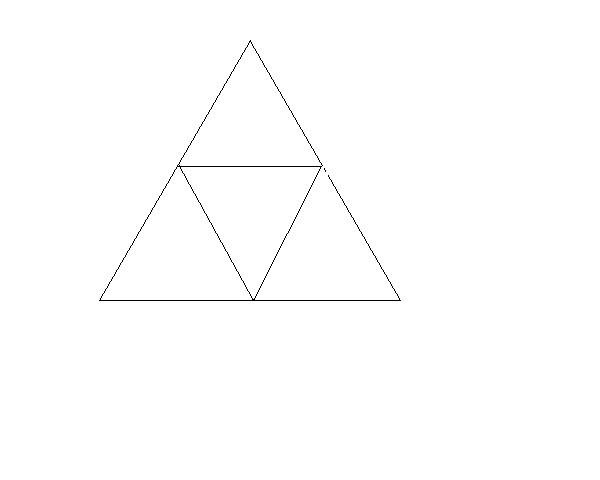hdu Counting Triangles
Given an equilateral triangle with n the length of its side, program to count how many triangles in it.


Input
The length n (n <= 500) of the equilateral triangle's side, one per line.
process to the end of the file
process to the end of the file
Output
The number of triangles in the equilateral triangle, one per line.
Sample Input
1 2 3
Sample Output
1 5 13
 View Code
View Code
1 #include<iostream> 2 #include<stdio.h> 3 #include<string.h> 4 using namespace std; 5 int main() 6 { 7 int n; 8 while(~scanf("%d",&n)) 9 { 10 int d[5]; 11 d[0]=0; 12 d[1]=1; 13 d[2]=5; 14 d[3]=13; 15 if(n<=3) 16 { 17 printf("%d\n",d[n]); 18 continue; 19 } 20 int i; 21 for(i=4;i<=n;i++) 22 { 23 d[4]=d[3]+2*i-1+(i*i-i)/2; 24 if(i%2==0) 25 d[4]=d[4]+(i-3+1)*(i-2)/4; 26 else 27 d[4]=d[4]+(i-3)*(i-1)/4; 28 d[3]=d[4]; 29 } 30 printf("%d\n",d[4]); 31 } 32 return 0; 33 } 34 35 36
递推题,想法如下:
首先知道了D(1)=1,D(2)=5,D(3)=13;
在手动推出D(4)=27,D(5)=48,然后 不难发现,D(n)=D(n-1)+X,
而这里的X还不确定,根据画出来的图可以看出,当n=4时,D(4)=D(3)+4*2-1+3+2+1+1,
D(5)=D(4)+5*2-1+4+3+2+1+2;
看出规律后,试着假设D(6)=D(5)+6*2-1+5+4+3+2+1+3,
可是画图发现,最后面加的那个数不是3,而是4,即:D(6)=D(5)+6*2-1+5+4+3+2+1+4,
也就是说,D(6)=D(5)+6*2-1+5+4+3+2+1+3+1;
而D(5)=D(4)+5*2-1+4+3+2+1+2+0;
继而再一次假设,当n为偶数时,有D(n)=D(n-1)+n*2-1+(n-1)+(n-2)+...+1+(n-3)+(n-5)+..+1;
当n为奇数时,D(n)=D(n-1)+n*2-1+(n-1)+(n-2)+...+1+(n-3)+(n-5)+..+0;
详细有代码……


